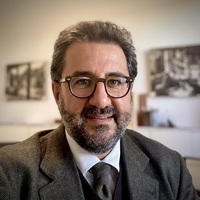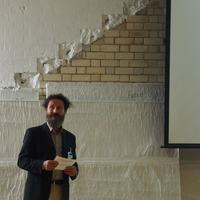Papers by Yildiz Salman

RA restauro archeologico, 2024
When the Venice Charter was published in 1964, the preservation of 20th Century or Modern Archite... more When the Venice Charter was published in 1964, the preservation of 20th Century or Modern Architectural Heritage was not yet a global problem. Following international documents addressing various additional aspects and conservation theory based on the Charter expanded the definition of monument focused on the tangible significance of the architectural product, from the iconic to everyday places, and the tool for evaluation is changed from a criteria list to a value-based approach. Although there appears to be a common understanding about the diverse architectural heritage of the earlier periods in preservation laws worldwide, there is no such consensus about the 20th century due to the theoretical difficulties in evaluating the recent past and this situation results in risks against their recognition and proper restoration practices. This paper aims to create a new discussion platform for our neoliberal world based on the current challenges of value assessment and limits of change.
This work is licensed under a Creative Commons Attribution-NonCommercial 4.0 International License.
... Boğaziçi tarihi sit alanının yokoluş süreci Yıldız SALMAN*, Doğan KUBAN ... Kentin uzantısı o... more ... Boğaziçi tarihi sit alanının yokoluş süreci Yıldız SALMAN*, Doğan KUBAN ... Kentin uzantısı olarak denizin iki yakasında ge-lişmiş ve kendine özgü bir yaşama kültürü ya-ratmış olan Boğaziçi de bu değişimden payına düşeni almıştır. ...
Meltem �zmir akdeniz akademisi dergisi, 2021

tasarım+kuram, 2023
Leyla Turgut, one of Turkey’s first female architects who contributed to the architecture of the ... more Leyla Turgut, one of Turkey’s first female architects who contributed to the architecture of the 20th century, was born in 1911in Istanbul. She lived in Vienna during her childhood and youth. Between 1926 and 1929, she completed high school at the Schottengymnasium. After graduating from high school, she started studying architecture in Vienna. Young Leyla was also a successful swimmer. She achieved a degree in swimming: On August 18, 1929, she broke the record by swimming the 18-kilometer-long Lake Wörthersee in about nine hours. She founded Vienna’s first women’s ice hockey team in 1930 with her friends from the ice-skating club. Leyla Turgut moved from Vienna to her hometown with her family in 1932. After settling in Istanbul, she became known for her achievements in swimming. In the 1930s, organizing swimming competitions to attract attention to aquatic sports was prevalent. Leyla Turgut won all her competitions and broke many records in 1933. The USSR invited Turkish athletes to compete in 1934. Two female swimmers in the national team, Leyla Turgut and Cavidan Erbelger were also Turkey’s first national female athletes. In the Turkish National Swimming Competition of 1935, she contributed to the championship of the Istanbul team with her successes. She started her architectural education at the Academy of Fine Arts in the mid-1930s again. She gained her first professional experience while still a student: In February 1937, she started working in the Architectural Practice Bureau, affiliated with the Ministry of Education. The head of the Architectural Practice Bureau was Bruno Taut, and he was also a professor at the Academy. During the years Leyla Turgut studied architecture, being a student and a colleague of Bruno Taut influenced her career planning. Taut designed social housing projects that thousands of Berliners settled in the 1920s. Thus, the issues Leyla Turgut worked on most as an architect were social housing projects. After graduating from the Academy of Fine Arts, she participated in architectural project competitions. While village institutes, an essential step for rural education, organized architectural design competitions to select the institute buildings in the early 1940s. She won awards in four design competitions and even the first prize in the Akpınar Village Institute competition and consulted for building this institute. She also won awards and honorable mentions from other architectural design competitions between 1944-1946.
On the other hand, she started to work for Istanbul Municipality in the late 1940s. In these years, Istanbul Municipality developed projects under Henri Prost’s leadership for the city’s modernization and renewal. The most critical urban issue of the period was the housing problem. As an architect of the Istanbul Municipality, Leyla Turgut worked on the master and development plans of the housing estates where low-income and poor people can shelter. In addition, with Sahip Özden, she designed the Selamsız and Koşuyolu social housing that the Municipality built. In the following years, with the activity of the cooperative dwelling association and Emlak Kredi Bank, these two areas developed further and became essential neighborhoods of Istanbul.
In the mid-1950s, she established an architectural company with her young associate Berkok İlkünsal. The only known project they designed together is Okmeydanı IETT Mass Housing. These housing units were among the initial samples of high-rise residential buildings and Istanbul’s first skyscrapers. In 1965, the German television channel Bayerischer Rundfunk broadcasted a film about daily life in Turkey. In this television film, there are scenes of Leyla Turgut consulting the construction works of the Okmeydanı IETT Mass Housing. She briefly explained the living conditions of women in Turkey before the Republic time in her voice. 1973 was the 50th anniversary of the republic’s proclamation, and the first Istanbul Festival was a part of the celebrations. The festival’s general manager, in which numerous local and foreign artists performed, was Leyla Turgut.
She died on March 28, 1988, at the age of 77. Her archive, consisting of valuable photographs and collections, was distributed to various museums after her death. She did not become a ‘starchitect’ focused on creative designs or following any movements during her career. Consequently, her architectural works have yet to be studied enough, despite much research about her contemporaries. Today, people remember Leyla Turgut with respect as a successful athlete and an intellectual architect. The study aims to examine the life story of a female architect worried about a developing country. Moreover, she worked to find solutions by focusing on the details of her architectural works.
ARCHive-SR, May 27, 2018
Tourism has begun to develop with the development of the socioeconomic structures of the countrie... more Tourism has begun to develop with the development of the socioeconomic structures of the countries after the Second World War and has become one of the fastest growing and expanding sectors in the world economy since this period.
“The Conservation of Modern Architectural Heritage and DOCOMOMO_Turkey”, Y. Salman, N. Baturayoğl... more “The Conservation of Modern Architectural Heritage and DOCOMOMO_Turkey”, Y. Salman, N. Baturayoğlu Yöney, E. Omay Polat, E. Altan Ergut, Betonart (Beton, Mimarlık ve Tasarım) 36/2013, Tema/Theme: Koruma/Architectural Preservation, D. Özkut (ed.) (ISSN 1304-494X): 52-57.
Betonart, 2021
Zeynep Kamil Hospital was constructed in the late 19th century on land adjacent to the cemetery. ... more Zeynep Kamil Hospital was constructed in the late 19th century on land adjacent to the cemetery. Since the 1950s, this environment has been transforming and the population has increased. The hospital has also grown in capacity with the new buildings. In this context, the construction of a children's pavilion (polyclinic) commenced in 1955 and was ready for use in 1958. The facade of the pavilion, above all the entrances, was impressive. Architects with major desings like Cahit Güneri and Fazıl Aysu are involved in the project. The children's pavilion was of great importance to Istanbul with its architectural features and social functions. Unfortunately the architectural characteristics were lost in the renovations in the 2010s.
A Model for an Integrated Multi-disciplinary Approach for the Preservation of 20th Century and Mo... more A Model for an Integrated Multi-disciplinary Approach for the Preservation of 20th Century and Modernist Architectural Heritage Yıldız Salman1; Zeren Önsel Atala2; Nilüfer Baturayoğlu Yöney3 1 Asst. Prof., Ph.D., Istanbul Technical University, Department of Architecture, Istanbul, Turkey; 2 Res. Asst., Ph.D. candidate, Istanbul Technical University, Department of Architecture, Istanbul, Turkey; 3 Asst. Prof., Ph.D., Abdullah Gül University, Department of Architecture, Kayseri, Turkey
New directions for youth development, 2003
Response to the events of 9/11 evidenced the need for greater local and national capacity to meet... more Response to the events of 9/11 evidenced the need for greater local and national capacity to meet the needs of children and families before, during, and after future attacks.
Lecture Notes in Civil Engineering
The change in politics in Turkey after World War II was reflected in the rapid transformation of ... more The change in politics in Turkey after World War II was reflected in the rapid transformation of the built environment as well. The increasing rate of urbanization in the 1950s led to a great lack of housing and soon to uncontrolled development, especially in the form of squatter zones. Economic problems and the lack of building materials limited construction activity and raised the prices. However the army intervention in 1960 and the 1961 Constitution brought about a general socialist tendency, embracing the idea of a welfare state, which transformed the nature of the national building activity yet again.

International Journal of Heritage Architecture: Studies, Repairs and Maintence, Jan 15, 2017
Beginning from the 1960s, cities in Turkey continue dealing with a constant and rapid transformat... more Beginning from the 1960s, cities in Turkey continue dealing with a constant and rapid transformation which causes great pressure particularly for the 20th century and Modernist architectural heritage in those cities. Threat of rapid urbanization is not limited to big cities but also valid for those Anatolian cities planned in between the 1920s and 1960s. The main risk is the limited understanding of integrity and authenticity concepts by decision-makers and planners. For those cities which are visually and aesthetically disowned of a numerous historic layers, they require a careful management of change. The integration of historic preservation with general urban planning decisions is substantial and should aim for the preservation of fundamental, spatial, environmental and social balances. Small Anatolian cities planned between 1920 and 1960 have a significant urban layer dating back to the early 20th century, which forms an integral part of public and urban memory, and the perception of the place. The lack of a systematic legislation and capital based approach supported by authorities especially cause the loss of Modernist architectural heritage. This article aims to propose a methodology for a holistic preservation approach for three cities in west Anatolia, Akhisar, Alaşehir and Tire, where existing features of modern planning period is a part of their authentic character.

BETONART 65.SAYI, 2020
Koşuyolu as a designed neighborhood is one of the pioneer initiatives of the municipality to meet... more Koşuyolu as a designed neighborhood is one of the pioneer initiatives of the municipality to meet the increasing demand for “low-cost housing”, towards the 1950s. Planned between 1949 and 1956, the first stages were completed by 1953. Leading planners and architects of
the period like Kemal Ahmet Aru, Rebii Gorbon, Seyfi Arkan, Leyla Turgut, and Sait Özden were involved in the planning process between the years 1948-1956. The “modern neighborhood” of the 50s merits to be considered as a cultural heritage place considering physical and social importance. Although the site still preserves some of its heritage values
and preservation possibilities, regarding challenging conditions, many negative effects of the contemporary urban dynamics like functional and physical transformations are a grave threat.
Koşuyolu Neighborhood, like few, left similar housings in the city as a representative of the 50s İstanbul merits an integrated planning and preservation approach.
Dosya_43 modern mimarlık mirası, 2019
Journal of Architectural Conservation, 2004

IPHS 2010 Istanbul Conference Proceedings, Jul 10, 2010
The change in politics in Turkey after World War II was reflected in the rapid transformation of ... more The change in politics in Turkey after World War II was reflected in the rapid transformation of the built environment as well. The increasing rate of urbanization in the 1950s led to a great lack of housing and soon to uncontrolled development, especially in the form of squatter zones. Economic problems and the lack of building materials limited construction activity and raised the prices. However the army intervention in 1960 and the 1961 Constitution brought about a general socialist tendency, embracing the idea of a welfare state, which transformed the nature of the national building activity yet again. U R B A N T R A N S F O R M A T I O N : C o n t r o v e r s i e s , C o n t r a s t s a n d C h a l l e n g e s 2 In the social justice ridden cultural environment after the 1960 army intervention, the social and architectural structure of Ataköy project and the bank were widely criticized, and the project was revised due to economic and political reasons to include smaller flats. Although this was a modernist urban planning exercise where the same principles were also reflected in architectural design and vocabulary, including sanitary, transportational, environmental, social, cultural and recreational infrastructure, it was no Siedlung in the European sense and the architecture was modernist only in form but not in philosophy. This stylistic choice also conformed to the national policies and public life, in which western economical, social and cultural models were quickly adapted. The project fitted in with the post-war modernist revival in Turkey, and today has heritage quality as one of the best examples of the period.
Y. Salman (ITU), Z. Önsel Atala (ITU), N. Baturayoğlu Yöney; presented and to be published in the... more Y. Salman (ITU), Z. Önsel Atala (ITU), N. Baturayoğlu Yöney; presented and to be published in the Proceedings of the Built Heritage (BH) 2013 – Monitoring Conservation Management, L. Toniolo, M. Boriani, G. Guidi (eds), Milan, Italy: Springer, in publication (2014); Politecnico di Milano, Milan, Italy, 18-20 November 2013.
Journal Articles by Yildiz Salman

RA restauro archeologico, 2024
When the Venice Charter was published in 1964, the preservation of 20th Century or Modern Archite... more When the Venice Charter was published in 1964, the preservation of 20th Century or Modern Architectural Heritage was not yet a global problem. Following international documents addressing various additional aspects and conservation theory based on the Charter expanded the definition of monument focused on the tangible significance of the architectural product, from the iconic to everyday places, and the tool for evaluation is changed from a criteria list to a value-based approach. Although there appears to be a common understanding about the diverse architectural heritage of the earlier periods in preservation laws worldwide, there is no such consensus about the 20th century due to the theoretical difficulties in evaluating the recent past and this situation results in risks against their recognition and proper restoration practices. This paper aims to create a new discussion platform for our neoliberal world based on the current challenges of value assessment and limits of change.











Uploads
Papers by Yildiz Salman
On the other hand, she started to work for Istanbul Municipality in the late 1940s. In these years, Istanbul Municipality developed projects under Henri Prost’s leadership for the city’s modernization and renewal. The most critical urban issue of the period was the housing problem. As an architect of the Istanbul Municipality, Leyla Turgut worked on the master and development plans of the housing estates where low-income and poor people can shelter. In addition, with Sahip Özden, she designed the Selamsız and Koşuyolu social housing that the Municipality built. In the following years, with the activity of the cooperative dwelling association and Emlak Kredi Bank, these two areas developed further and became essential neighborhoods of Istanbul.
In the mid-1950s, she established an architectural company with her young associate Berkok İlkünsal. The only known project they designed together is Okmeydanı IETT Mass Housing. These housing units were among the initial samples of high-rise residential buildings and Istanbul’s first skyscrapers. In 1965, the German television channel Bayerischer Rundfunk broadcasted a film about daily life in Turkey. In this television film, there are scenes of Leyla Turgut consulting the construction works of the Okmeydanı IETT Mass Housing. She briefly explained the living conditions of women in Turkey before the Republic time in her voice. 1973 was the 50th anniversary of the republic’s proclamation, and the first Istanbul Festival was a part of the celebrations. The festival’s general manager, in which numerous local and foreign artists performed, was Leyla Turgut.
She died on March 28, 1988, at the age of 77. Her archive, consisting of valuable photographs and collections, was distributed to various museums after her death. She did not become a ‘starchitect’ focused on creative designs or following any movements during her career. Consequently, her architectural works have yet to be studied enough, despite much research about her contemporaries. Today, people remember Leyla Turgut with respect as a successful athlete and an intellectual architect. The study aims to examine the life story of a female architect worried about a developing country. Moreover, she worked to find solutions by focusing on the details of her architectural works.
the period like Kemal Ahmet Aru, Rebii Gorbon, Seyfi Arkan, Leyla Turgut, and Sait Özden were involved in the planning process between the years 1948-1956. The “modern neighborhood” of the 50s merits to be considered as a cultural heritage place considering physical and social importance. Although the site still preserves some of its heritage values
and preservation possibilities, regarding challenging conditions, many negative effects of the contemporary urban dynamics like functional and physical transformations are a grave threat.
Koşuyolu Neighborhood, like few, left similar housings in the city as a representative of the 50s İstanbul merits an integrated planning and preservation approach.
Journal Articles by Yildiz Salman
On the other hand, she started to work for Istanbul Municipality in the late 1940s. In these years, Istanbul Municipality developed projects under Henri Prost’s leadership for the city’s modernization and renewal. The most critical urban issue of the period was the housing problem. As an architect of the Istanbul Municipality, Leyla Turgut worked on the master and development plans of the housing estates where low-income and poor people can shelter. In addition, with Sahip Özden, she designed the Selamsız and Koşuyolu social housing that the Municipality built. In the following years, with the activity of the cooperative dwelling association and Emlak Kredi Bank, these two areas developed further and became essential neighborhoods of Istanbul.
In the mid-1950s, she established an architectural company with her young associate Berkok İlkünsal. The only known project they designed together is Okmeydanı IETT Mass Housing. These housing units were among the initial samples of high-rise residential buildings and Istanbul’s first skyscrapers. In 1965, the German television channel Bayerischer Rundfunk broadcasted a film about daily life in Turkey. In this television film, there are scenes of Leyla Turgut consulting the construction works of the Okmeydanı IETT Mass Housing. She briefly explained the living conditions of women in Turkey before the Republic time in her voice. 1973 was the 50th anniversary of the republic’s proclamation, and the first Istanbul Festival was a part of the celebrations. The festival’s general manager, in which numerous local and foreign artists performed, was Leyla Turgut.
She died on March 28, 1988, at the age of 77. Her archive, consisting of valuable photographs and collections, was distributed to various museums after her death. She did not become a ‘starchitect’ focused on creative designs or following any movements during her career. Consequently, her architectural works have yet to be studied enough, despite much research about her contemporaries. Today, people remember Leyla Turgut with respect as a successful athlete and an intellectual architect. The study aims to examine the life story of a female architect worried about a developing country. Moreover, she worked to find solutions by focusing on the details of her architectural works.
the period like Kemal Ahmet Aru, Rebii Gorbon, Seyfi Arkan, Leyla Turgut, and Sait Özden were involved in the planning process between the years 1948-1956. The “modern neighborhood” of the 50s merits to be considered as a cultural heritage place considering physical and social importance. Although the site still preserves some of its heritage values
and preservation possibilities, regarding challenging conditions, many negative effects of the contemporary urban dynamics like functional and physical transformations are a grave threat.
Koşuyolu Neighborhood, like few, left similar housings in the city as a representative of the 50s İstanbul merits an integrated planning and preservation approach.
Secretariat of DOCOMOMO_Turkey National Working Party, DOCOMOMO Journal 27, June 2002: 82-83.
Turchia, N. Baturayoğlu Yöney, Y. Salman, E. Omay Polat
Umberto Allemandi & C., Italy, 2013
media accelerations of contemporary architecture put in evidence deficiencies in protection laws in Italy and abroad.
The work suggests the need to establish a system of shared criteria for updating the Italian normative. A study that compares and contrasts the development of the conservation laws and the current intervention strategies on an international scale, as a function of identity in flux.
KORUMA
Geçmiş | Bugün | Gelecek Arasındaki Diyalog
26-27-28 Ekim 2017
TED Üniversitesi Mimarlık Fakülteltesi, TMMOB Şehir Plancıları Odası Ankara Şubesi, ODTÜ Kültürel Miras Koruma Lisansüstü Programı
65.sayıda Koşuyolu Mahallesi, Selamsız Ucuz Evler, Balmumcu Güzel Konutlar Sitesi, Veliefendi İşçi Blokları, Seyrantepe Oto Sanayi Sitesi, Tozkoparan Sosyal Konutları ve Doğu Sanayi Sitesi; kentin genişleyen sınırlarını tarifleyen ve inşa edildikleri dönemde, kendi kategorilerinde ilk olma değeri taşıyan, önemli isimlerin tasarım süreçlerine katkıda bulunduğu ancak zaman içinde değişen kentsel bağlamları ile günümüzde tümüyle sıradanlaşmış ve görünmez olan konut ve endüstri yapıları olarak ele alınıyor.
İstanbul Teknik Üniversitesi FBE Restorasyon Doktora Programı’nda Yıldız Salman’ın yürüttüğü Conservation of Modern Architectural Heritage dersi kapsamında yapılan araştırmalardan ve Yıldız Teknik Üniversitesi’nde Ebru Omay Polat’ın danışmanlığında tamamlanan bir yüksek lisans tezinden üretilen yazılara konu olan yapılar, sayıda okuyucuya kronolojik sıra ile sunuluyor.
Bu makaleye konu olan araştırma 2015-16 akademik yılı bahar döneminde İTÜ Fen Bilimleri Enstitüsü Restorasyon Yüksek Lisans Programı Koruma Projesi II dersi kapsamında yazarlar tarafından hazırlanan Mudurnu
Kentsel Koruma Projesi’nden üretilmiştir. Bu çalışma, Temmuz 2021 tarihindeki alan ziyareti sırasındaki güncellemeler sonrasında hazırlanmıştır.
Bu çalışmada Liman Dok İşçi Sitesi tarihsel bağlamı içerisinde değerlendirilmiştir. Literatür taraması, arşiv araştırması ve alan çalışması ile geçmişi ve güncel durumu hakkında tespitler yapılarak Üsküdar’ın 20. yüzyıl katmanına ait bu modern yerleşimin miras değerleri açıklanmış ve alanın korunmasına yönelik önerilerde bulunulmuştur.